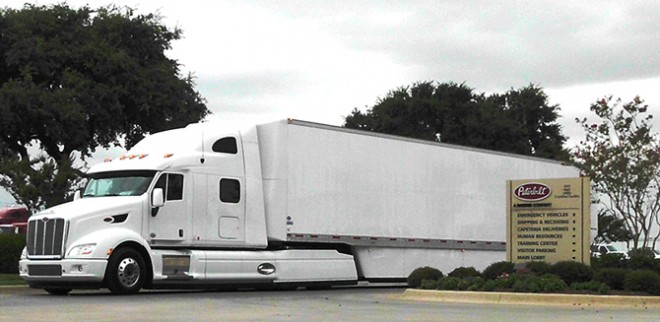DOE Teams Drive Closer to the Future of Trucking
With tractor-trailers accounting for 12 percent of fuel consumption in the United States, big rigs don't get their name for size alone. As a result, these highway goliaths have been a focus of the Department of Energy's SuperTruck program—an effort that will hopefully cut fuel consumption in half across the industry.
 We've already heard about one SuperTruck team, Navistar, who has been working in concert with Lawrence Livermore National Laboratory (LLNL) to deliver the next generation of tractor-trailer. But a second team, made up of truck maker Peterbilt Motors Co. and engine manufacturer Cummins Inc., has now test-driven a super truck of their own.
We've already heard about one SuperTruck team, Navistar, who has been working in concert with Lawrence Livermore National Laboratory (LLNL) to deliver the next generation of tractor-trailer. But a second team, made up of truck maker Peterbilt Motors Co. and engine manufacturer Cummins Inc., has now test-driven a super truck of their own.
In a demonstration of real-world driving conditions, the truck boasted a fuel economy of 9.9 mpg. While that may not sound so “super,” it represents a 54 percent increase in fuel economy over existing tractor trailers, and could mean a savings $25,000 in diesel costs each year. Not only that, but annual greenhouse gas emissions per truck would be lowered by 35 percent.
Within the DOE's SuperTruck program, the five manufacturers competing must reach their 50 percent fuel reduction goal through engine improvements, weight reduction, drivetrain refinement and aerodynamic enhancements. Up to 40 percent of the fuel efficiency gains can come from changes to the engine, but at least 60 percent must come from the aerodynamic and drivetrain tweaks.
Like most of its competitors, Peterbilt and Cummins have paid close attention to waste-heat recovery and aerodynamic improvements, focusing on converting heat into power and reducing friction within the engine and reducing drag created by the tractor-trailer combination. An advanced transmission has also been added to help the engine run at lower speeds.
This truck's 9.9 mpg average was calculated over 11 312-mile test runs between Fort Worth and Vernon, Texas. While this is undoubtedly an improvement over existing rigs, some truckers have expressed doubt as to whether the impressive fuel economy gains will extend into hilly or congested road conditions.
But even if their doubts were to be proven true, this demonstration has shown us just how much extra fuel we can squeeze from existing technology—a lesson we shouldn't be quick to dismiss.
Full story at Wired










